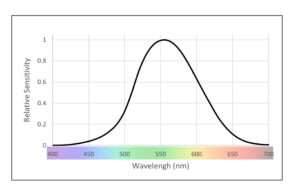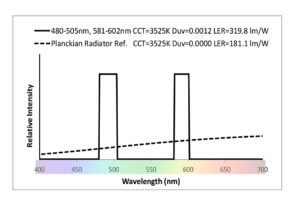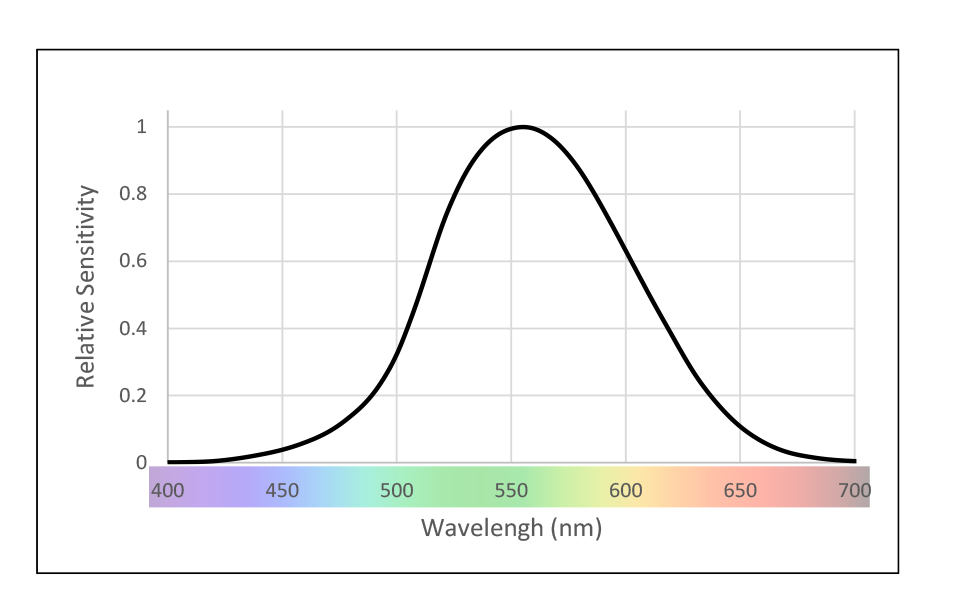The Lumen What it’s for, and what it’s not
One can generally see fine with enough illuminance, which is the luminous flux (unit: lumen) per area.
The unit of illuminance is lux if the area is measured in sq meters, and footcandles (fc) if sq ft are used. Setting aside other aspects of the lit environment for the moment, a normally-sighted person can see very well over a very wide range of illuminance values. (For example this is often about 10,000 fc outdoors and about 50 fc in offices).
However, even though there is a very wide range of acceptable illumination levels, quantifying illumination is necessary, just as well-defined metrics are needed in most aspects of commerce and science. Manufacturers need design targets; specifiers and consumers need comparison tools. However, it is critical to use these tools only for what they are. The lumen is precisely defined and readily measured, but that does not make it a complete predictor of visual experience. Illuminance is just one aspect of lighting design. On its own, it fails to adequately predict the full value of the quality and effectiveness of illumination in a space. Despite the widespread assumption that it provides the most critical information, it is more appropriately used as only one of several approximate indicators concerning the human visual experience of a space.
The definition of the lumen arises from candela¹ which is based on a precisely specified monochromatic green light at 555 nm—the suggested peak of the visual system’s spectral sensitivity. When evaluating light of many wavelengths (e.g., white light), it is necessary to take into account the complete sensitivity curve of human vision, which peaks near 555 nm but falls to zero at the edges of the visible spectrum (Figure 1). A key difficulty, however, is that the pattern of visual sensitivity varies somewhat between individuals, with age, and the details of the measurement method. (Methods based on flicker sensitivity, visual acuity and perceived brightness yield similar, but not identical, response curves.) The CIE’s 1924 spectral luminous efficiency function (aka V(λ)) for photopic vision is a hybrid, standardized curve based on experiments using different methods allowing the calculation of photometric measures (e.g., illuminance). While that definition is precise, illuminance is not a precise predictor for all forms of visual response—a key point that is often missed.
V(λ) has other known limitations, such as the small field of view within the retina’s central fovea. Excluded regions of the retina have light sensitive cells that respond differently. While V(λ) provides approximate information that can be useful, there are possibly more appropriate, emerging concepts to quantify the amount of light, such as spatial brightness² which admittedly needs further development and evaluation.

The lumen is precisely defined and readily measured, but that does not make it a complete predictor of visual experience
What then, is a lighting practitioner to do? Here’s a simple solution: in many design contexts, it is appropriate to de-emphasize reliance on photometric quantities alone (e.g., lumens, lux, fc) in decision-making. Fortunately, the precise level of illuminance is just not very critical. Remember that when designing illumination for humans, over-emphasizing the exact quantity of illuminance under-emphasizes the quality of lighting, which can reduce human well-being. Lighting decision-makers have an ethical responsibility to optimize outcomes by assigning the correct relative priority to each of the key relevant design factors, rather than constraining a project according to a single measure. Bluntly, over-emphasing the lumen under-emphasizes wellbeing, and that’s irresponsible.
Here’s an example: clearly, someone who wanted to keep their job would not illuminate an office with monochromatic green light, even though that would be the most efficacious (remember the peak sensitivity of V(λ)). It is accepted that white light is more appropriate, even if it provides fewer lumens per watt according to the photopic curve. It is a no- brainer! That’s why it is unlikely that you’ll accidentally purchase a green lamp at a hardware store.
However, suppose we consider a white light that only provides some of the visible wavelengths. We could get away with this by making sure that the wavelengths we do provide appear white when blended together—in other words we could game the system. This line of reasoning produces a spectrum that does appear white (Figure 2) and has way more lumens per watt of radiant power. Here’s the catch: under such a distorted spectrum, some objects may look abnormal (e.g., healthy people would look like zombies; strawberries would not look red). Fortunately, there are standards and recommendations (i.e., IES Fig. 1 The CIE spectral luminous efficiency function (photopic curve) TM-30)³ to ferret out unwanted color distortions.
Another consideration is competition between lamp manufacturers. A manufacturer might make a great luminaire delivering 900 lumens, with unsurpassed quality in every aspect, including spatial efficiency (delivering more light where needed for less power consumption). But if customers insist on 1,000 lumens, that luminaire would not be considered even though it could be the best choice overall and provide wonderful illumination.

It is important to appreciate that the amount of visible light is less important than its overall quality. Just as we use the term “junk food” for servings that have plenty of calories but little nutritional value, perhaps we should use “junk light” to describe illumination that has plenty of lumens, but distorts color appearance, has poor distribution, is glarey or otherwise offers little actual value.
Instead of using junk light, let us save energy by using less energy. In the case of light, we might need less than assumed as long as it is well delivered. The lumen alone is not a proxy for appropriateness or quality. The usefulness of the delivery of light in architectural spaces can be better calculated with more relevant methods, such as lighting application efficacy instead of luminous efficacy. Let us all move the lumen into context with the myriad of other important considerations. It is time to select luminaires that provide optimal benefits. Some have described this as optimizing the “joy per joule”.
Optimizing joy per joule wastes no energy, and it improves human wellbeing, so let’s do it.




